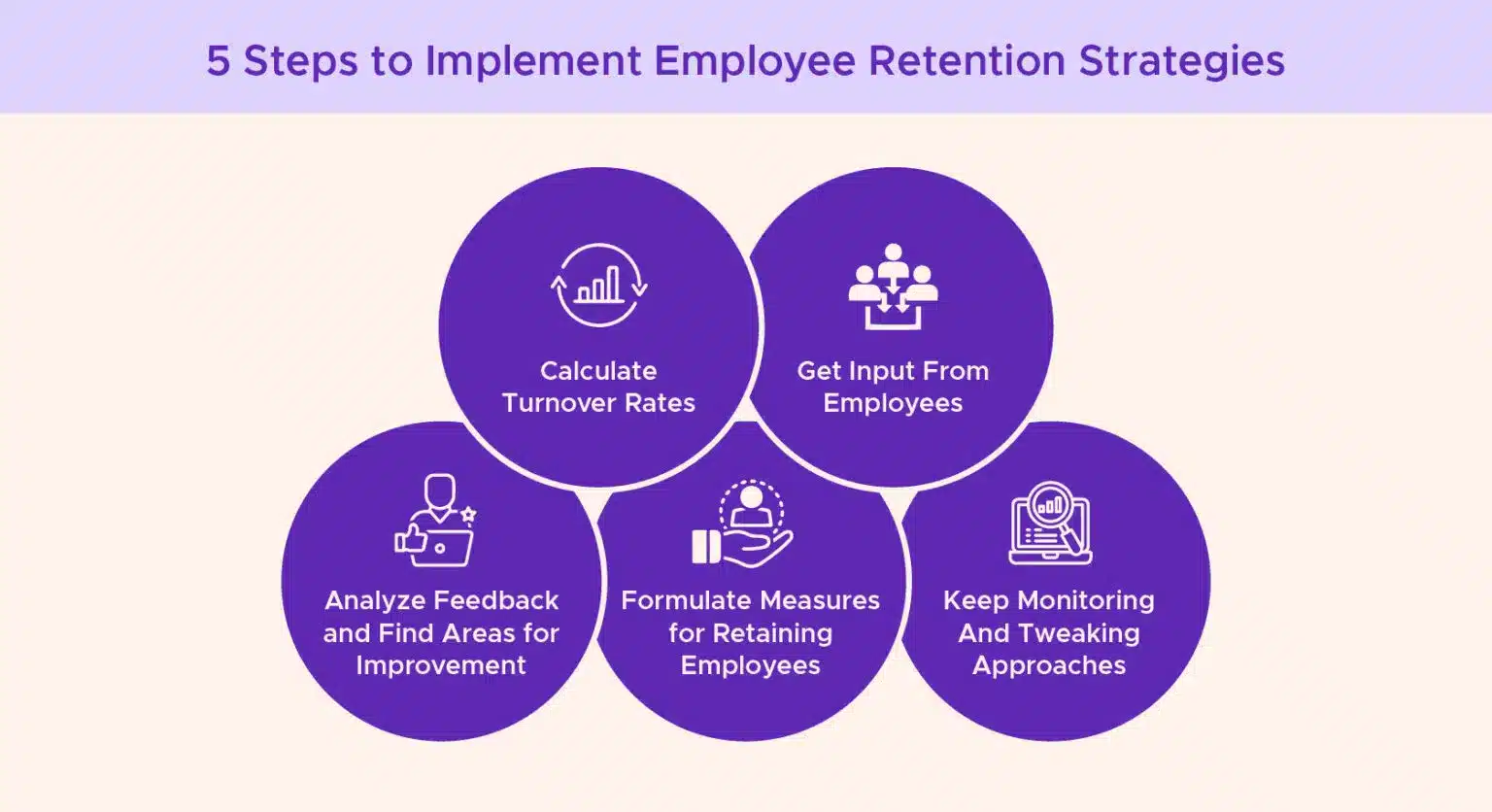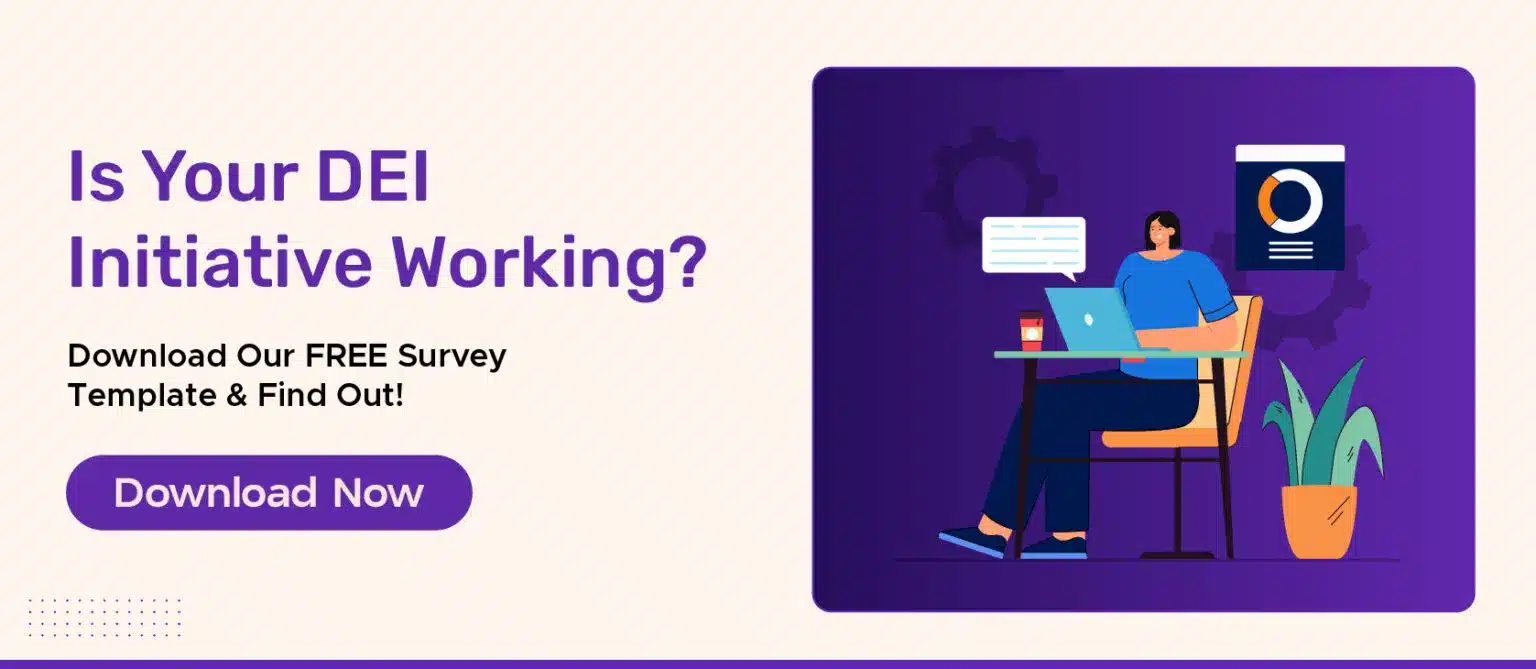SHRM found that losing employees cost you three to four times their salary.
Losing employees can cost you anywhere from 50% to 200% of the employee’s annual salary once you take into account recruitment, onboarding, and training costs as well as lost productivity during this period.
In this article, we’ll show you how to build an effective employee retention strategy, along with 10 tried and tested employee retention strategies that you can get started on today.

Why Does Employee Retention Matter?
Retaining staff is important — we know this. But why is it so vital to running a successful business, or creating a good reputation in the market? Let’s look at the reasons.
More people leaving means higher costs for replacement
You’ll have to replace the employees who leave your company, and if this number is on the higher side, you’ll overspend on advertising vacancies or hiring agencies. In addition to these fees, there is also an expense associated with getting them up-to-speed (which can take months) through induction programs or other forms of training. All these things combined can place great strain on any organization financially.
Productivity losses and erosion of institutional knowledge
When experienced employees walk out, they take with them skills that cannot easily be replaced. This could stifle innovation, damage client relationships and put additional stress on those who remain behind as they struggle with the additional workload.
A stable work environment attracts the best staff and helps retain your employees
When the average tenure of any employee in your company is longer, job security becomes a part of your employer brand. Not only does this mean that your existing employees will tend to feel supported and happy, but it attracts new talent who want to be part of a secure workplace, especially in these times of rampant layoffs. So your existing employees will be more loyal, while potential employees will give you serious consideration over others.
Effective employee retention strategies drive long-term success
In the long run, better employee retention will lead to loyal employees who work at higher productivity levels. You will, too, as you are not stuck in a vicious cycle of hiring and training. This heightened productivity gives you a clear advantage over competitors who still haven’t rectified their problems with turnover.
It also gets easier to maintain client relationships, as they don’t witness a revolving door of employees at your organization. Clients can get comfortable working with your business, as it’s likely they will be communicating with the same employees over an extended period.
Top Reasons Why Employees Leave Jobs
What causes high turnover? Why do some companies boast of retaining employees while others struggle with it? Let’s find out.

Lack of growth in career and development opportunities
When an employee feels like their current position has no potential for advancement or skill-building, they may grow stagnant and frustrated. If a person is not being promoted over time, it is easy for them to think they are stuck in a rut, and the only way to get out is to find a better job or a more advanced role with another business.
Inadequate salaries, bonuses, and benefits packages
With new technology making information accessible from anywhere at any time, employees know what other companies are offering in terms of compensation packages. Failing to meet these standards and paying below market value will lead to your employees looking elsewhere to find a higher-paying job if they feel they’re being undervalued.
Weak leadership and poor management
Job satisfaction and retention, are highly influenced by how an employee gets along with their immediate boss. When leaders cannot lead or fail to give enough support and direction or create a stressful working atmosphere, employees start to think about quitting.
Lack of recognition and appreciation
When people feel that they are not given credit for what they do or that it is taken for granted, they tend to be less motivated towards their roles. Employees should be given feedback regularly, praised often, and rewarded tangibly before they start doubting their importance within the organization and look for other jobs where their work will be commended.
Poor work-life balance/inflexibility
Personal welfare and family commitments should always take precedence over jobs. An employee may quit if there is no flexibility shown by his/her employer when they need time off. Rigid timetables combined with excessive workload and a lack of remote working options all contribute towards burnout among employees — increasing your turnover rate in the long run. 80% of employees have suffered from burnout in the last year in the U.S., while 46% of these employees avoided sharing this with their manager.
Personal reasons
Sometimes people leave due to reasons you cannot control. For instance, relocating due to personal matters like family ties or health conditions could make someone resign despite being happy with what they do at work.
Once you know why turnover happens, you work on preventing it and ultimately create an environment where workers stay satisfied & loyal over extended periods.
5 Steps to Implement Effective Employee Retention Strategies
A comprehensive strategy aimed at holding onto staff members includes five steps:

Calculate Turnover Rates
To recognize why employees keep leaving a business voluntarily, you must first find out how many workers are exiting over any given period compared with other companies within your industry— AKA employee turnover rate.
Employee Turnover Rate = (Number of Separations / Average Number of Employees) × 100
Where:
- Number of Separations is the total number of employees who left the organization during the specified time period, including both voluntary and involuntary separations.
- The average Number of Employees is calculated as:
- Average Number of Employees = (Number of Employees at the Beginning of the Period + Number of Employees at the End of the Period) / 2
Compare your numbers to Industry standards to determine whether these rates are too high or too low. Use reliable sources like those provided by the Bureau of Labor Statistics.
Get Input From Employees
Regular surveys are key tools for collecting feedback to find out what it’s like working for you.
- Compare onboarding surveys and employee surveys to exit interviews to find common reasons affecting the retention rate. Is the attitude towards your workplace drastically different?
- Conduct structured onboarding surveys at 30-day, 60-day, and 90-day marks to highlight signs of early disengagement as well as low morale during the recruitment process.
- Exit interviews are also a great way to obtain honest opinions about why people are quitting the company. This can provide helpful data for future improvements. Evaluate how much of this is within the organization’s ability to change, whether it’s way of offering remote work opportunities or employee benefits.
- “Stay” interviews might be appropriate with longer-serving staff who consistently perform well to understand what factors keep them engaged within their current role beyond any financial reasons such as pay increases alone.
Analyze Feedback and Find Areas for Improvement for Retaining Employees
Once you have collected feedback from employees, it is important to study your findings carefully so that you can identify specific areas within the organization that need changes.
Analyzing employee feedback involves quantitative analysis, which entails looking at numbers or data sets, as well as qualitative methods like content analysis that focus on descriptions and themes arising from what people say.

Break down responses by department, location, or other demographic factors if possible — this will help pinpoint particular concerns (or successes) more precisely rather than just having an overall view across all participants together without considering differences between groups within bigger populations.
Think about how frequently certain issues were mentioned — if something came up time after time again (work culture, lower morale, lack of health insurance or flexible work options), then it’s worth addressing.
Formulate and Implement Measures for Retaining Employees
After you get feedback from your employees, you can use this to create and implement specific retention initiatives.
- Create a multidisciplinary team to come up with and execute programs aimed at retaining staff. The team should be made up of representatives from human resource management who have a good understanding of what employees are going through.
- Offer training as well as resources to managers on effective ways of retaining workers. Train them to give regular feedback and recognize achievements made by individuals.
- Establish a formal recognition system to deliver both monetary and non-monetary rewards for outstanding performance. Even smaller changes, like gift cards, can go a long way in enhancing the employee experience.
Keep Monitoring And Tweaking Approaches
To know if your retention measures are working, you need to monitor their success continuously. This allows you to lean into what is working, and stop dedicating resources to what isn’t.
- Set key indicators of performance (KPIs) against each staff retention initiative like participation rates and employee satisfaction scores.
- Evaluate progress frequently together with current employees from different departments to know whether the strategies are working according to expectations.
- Share information about what has been achieved with various stakeholders including top management, supervisors, and employees to foster transparency.
Want a simpler method to calculate employee turnover rate? Access our FREE turnover rate calculator today!
10 Proven Employee Retention Best Practices
Here are ten strategies that will help you establish a better relationship with your employees, win their trust, and improve retention levels.
Provide transparent, competitive pay
Your salaries and benefits package should be at least on par with those in similar positions at other firms in your industry. To boost employee morale in the long term, reassess these pay packets through periodic reviews of market prices. Open up about the philosophy behind reward system design so employees know how they are being rewarded and what they can do to work towards better compensation.

Offer visible learning and career development opportunities
Invest in different types of skill acquisition programs, such as training workshops or mentorships, to help with your employee’s professional development. Create clear paths to help them reach professional goals by tracking their skills and career mapping.
Communicate openly and honestly with employees
Communicating openly creates an atmosphere of trust between employers and managers. Keep updating workers about what is happening within the organization like what business goals are being set and organizational challenges faced. Create channels through which they can make inquiries about their own progress without having to wait till the next performance appraisal interview.
Performance management platforms like Peoplebox allow employees to have periodic check-ins that can be automated to streamline the feedback process and facilitate continuous improvement. Try it yourself!
Prioritize diversity and inclusion
Create a work environment that treats everyone fairly irrespective of gender identity, race background, or other protected characteristics. Establish policies/practices and implement DEI strategies that support equal representation, like a diverse team of managers, business leaders and stakeholders. Involve employees to brainstorm how they can work together without promoting or experiencing discrimination.

Allow flexible working hours
People’s expectations have changed dramatically over the last few years. Employees prefer having control over their own working hours, so offer work flexibility or compressed workweeks. Consider pushing for remote work arrangements, and find ways to help them strike a balance between their professional lives and personal commitments.
Create an environment where recognition thrives
Establish formal systems that celebrate any success achieved both individually and collectively by the teams involved. Encourage supervisors to deliver timely informal feedback accompanied by praise. Aim for variety when it comes to rewards offered (such as cash incentives vs non-monetary ones) depending on what each worker prefers most based on his/her values system.
Conduct “stay” interviews: These are intended to dig deeper beyond exit interviews and surface-level explorations and find out why certain people keep working for the same organization. Stay interviews conversationally probe into factors that influence job retention, like company culture.
Managers need to have one-on-one sessions throughout the year to identify issues early before they become major threats.
Promote friendships in the workplace
Creating strong relationships with coworkers is a key way to increase employee engagement, job satisfaction, and retention. This can be done by encouraging workers to socialize more often, such as through company-sponsored events and cross-functional projects.
Provide freedom to innovate
Empowering employees to take ownership of their work and contribute new ideas can boost engagement, productivity, and retention. Give employees the autonomy and resources they need to identify and solve problems creatively and encourage them to share their ideas and insights with the broader team.
Creating a safe workplace culture is one of the best ways to encourage experimentation and risk-taking, and celebrate both successes and failures as opportunities for learning and growth.
Invest in office space as well as employee wellness programs
The physical work setting has a significant influence on how people feel about their jobs. Invest in this area to improve morale and reduce turnover rates. For example, your organization could design collaborative spaces with ergonomic furniture or provide natural lighting through large windows.
Revolutionize Your Employee Retention Efforts with Peoplebox
Peoplebox aligns individual and team goals to broader organizational objectives, helping employees see how their work connects to the company’s overall goals. This alignment helps address disengagement and disconnect that can lead to attrition.
Peoplebox’s strong people analytics capabilities make it easy for you to monitor key data points, recognize patterns, and make data-driven talent management decisions. The analytics pull from performance reviews, engagement surveys and other touchpoints to proactively detect early signs of turnover risk.
Features like regular check-ins can also help you gauge team engagement and identify and reward high performers. With automated pulse surveys, you can regularly collect employee feedback to identify development opportunities.
Want to see the platform in action? Get in touch with us today!







